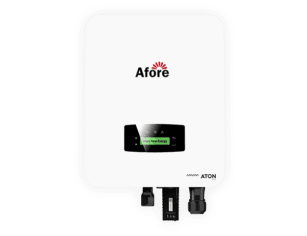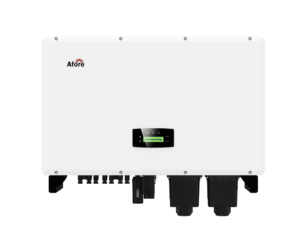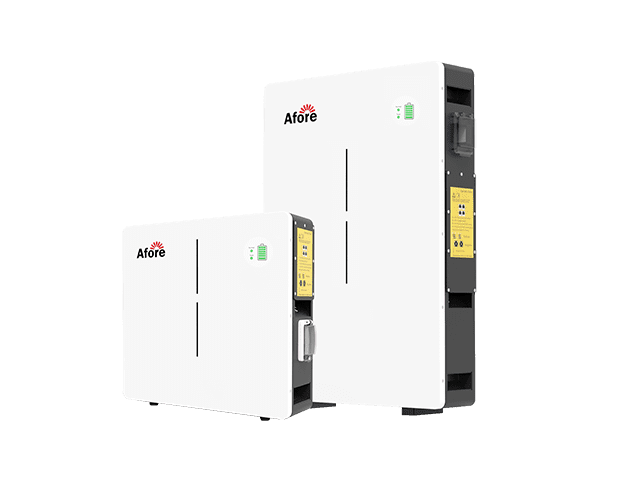What is a String Inverter? Exploring Its Function, Advantages, and Applications in Solar Energy

Table of Contents
Today, let’s step into the world of string inverters and explore the story and charm behind it.
String Inverters: Definition and How They Work
What is a string inverter? How does it work? Let’s unravel its mysteries together.
String Inverter Classification
String inverters, what is a string inverter, have become an indispensable bridge between solar energy and the power grid with their unique design concepts and high-efficiency conversion technologies. In this big family, single-phase string inverters and three-phase string inverters are like two bright stars. They shine in different fields and jointly promote the popularization and application of renewable energy.
The design of single-phase string inverters is very practical. It is usually compact and lightweight, easy to install and maintain. For most home users, a single-phase string inverter can be easily operated without much technical knowledge. What’s more, its cost is relatively low. This makes it possible for more families to afford the installation of solar systems and enjoy the convenience and environmental friendliness of green energy.
Three-phase string inverters are called “three-phase” because they can handle three-phase alternating current. Three-phase power has higher transmission efficiency and more stable power quality than single-phase power. It is therefore more suitable for high-power, high-stability industrial and commercial applications. Three-phase string inverters are able to fully utilize these advantages to provide a stable and reliable power supply to industrial equipment and commercial facilities.
In terms of design, a three-phase string inverter is usually larger and more powerful. It adopts advanced circuit design and control algorithms that enable efficient power conversion and intelligent grid adaptation. At the same time, it also has a variety of protection functions. For example, over-current protection, short-circuit protection, overheating protection, etc. This ensures stable operation in complex and changing industrial environments.

Technical Advantages of String Inverters
In the field of renewable energy, string inverters, with their unique design concepts and superior technical advantages, are like a bright star that lights up the way for many homes and businesses to install solar systems. Below, let’s passionately explore several technical advantages of string inverters.
Compared with other types of inverters, single-phase string inverters are like a caring friend, without the need for complicated installation steps and tedious debugging process, users only need a few easy steps to complete the installation work. This easy-to-install feature not only reduces the installation cost, but also improves the installation efficiency. It enables more families to easily step into the green energy hall and feel the warmth and light brought by solar energy.
String inverters are called “string” precisely because they are like pearls in a string, closely connected and designed to be connected to a string of solar panels connected in series. This design not only simplifies the system structure, but also significantly improves the overall efficiency of the system. By connecting the solar panels in series, the string inverter is able to capture every ray of solar energy more efficiently, converting more DC power into AC power. At the same time, the overall efficiency of the system is further enhanced by the reduction of cable connections and energy losses.
In terms of price, string inverters are like a breath of fresh air, offering significant advantages over other types of inverters. Due to its simple design and low production cost, string inverters are more affordable, like warm sunshine shining on the earth, so that more families and enterprises can afford the installation of solar energy systems, enjoy the economic benefits of green energy and environmental protection fun.
The string inverter also adopts Maximum Power Point Tracking (MPPT) technology, which is another major technical advantage. MPPT technology acts as an intelligent guardian that monitors the output voltage and current of the solar panels in real time, finds the maximum power point and adjusts the input voltage of the inverter to ensure that the system always operates at peak efficiency. This means that the inverter can extract the maximum amount of energy from the solar panels, thus increasing energy production and reducing electricity costs. For the user, this opens the door to wealth, meaning higher energy yield and lower electricity costs.
In addition to easy installation and efficient conversion, the string inverter is also easy to maintain. Like a reliable partner, it is compact, well-designed and requires little maintenance during operation. Once installed and in operation, the user can use it without worrying about frequent maintenance and the extra costs associated with replacing parts. This low-maintenance feature makes string inverters more economical and practical in long-term use. They are like a silent guardian, accompanying users through every green energy day and night.
What is even more delightful is that string inverters also have the function of intelligent grid back. When the power generated by solar panels exceeds the demand of a home or business, the excess power can be transmitted back to the grid through the string inverter for use by other users. This not only improves energy utilization and grid stability, but also allows users to enjoy the additional benefits of green energy. By participating in grid scheduling and power trading, customers can also further reduce their electricity bills and promote renewable energy. This feature is like a pair of wings for string inverters, allowing them to soar higher and farther in the sky of green energy.
Technical Disadvantages of String Inverters
What is a string inverter? It is a device used in solar energy systems where multiple solar panels are connected in series to generate electricity. One of the distinctive features of string inverter is the use of a series design in which multiple solar panel are connected together. However, this design also brings with it certain risk. If one of the solar panel perform poorly or fail, then the performance of the entire system is affected. This is because the failure or reduced performance of any one component in a series circuit will result in lower output voltage and current for the entire circuit. Therefore, in practice, if a solar panel is shaded, dusty, or damaged, it may cause the entire system to lose power generation efficiency. In some case, it could even fail to work properly.
This kind of limits restrict the application scope of string inverter to a certain extent. Especially in area with complex environmental conditions and unstable solar resources, such as cloudy, foggy or sandstorm-prone areas, the performance of string inverters may be greatly affected. In addition, for large-scale solar power plant or distributed PV system, the large number of solar panels make maintenance and management more difficult. This, in turn, further increases the risks associated with the string design.
String inverters are usually connected to the grid to deliver the power generated by the solar panels to the grid. However, string inverters may face greater challenges in remote areas or where the grid is unstable. If the grid is not functioning properly or there is not enough power stored to support the proper functioning of electronic devices, the string inverter will not be able to perform as well as it should.
This dependence on grid stability limits the application of string inverters in remote and underdeveloped grid areas. In these areas, string inverters may not work properly or be able to meet the power needs of users due to lagging grid construction or insufficient power supply. In addition, in the case of natural disasters or emergencies that cause grid interruptions, string inverters may not be able to continue supplying power. This can cause inconvenience and losses to users.
String Inverter Application Areas: Lighting Up Every Corner of Life
In the following, we will discuss in-depth the applications of string inverters, what is a string inverter, in different fields, showing their extensive influence as the core equipment for green energy conversion.
The Right-Hand Man for Home PV Systems
String inverter play a crucial role in home photovoltaic system. They not only help household to become energy independent, but also transmit excess power back to the grid. This brings additional economic benefits to the household. Many users have said that since installing a string inverter, their electricity bills have been significantly reduced and their quality of life has improved dramatically.
Green Power for Industrial and Commercial Sectors
String inverter also play an irreplaceable role in industrial production lines and commercial building. They can provide enterprises with a stable and reliable supply of green energy. Helping enterprises to realize the goal of energy saving and emission reduction. According to industry report, more and more companies are choosing to install solar system and string inverter to reduce energy consumption and operating costs.

The Future of String Inverters: Innovation Leads to the Future
With the increasing global emphasis on renewable energy and the continuous advancement of technology, string inverters are gaining significant attention. What is a string inverter? It is key equipment for green energy conversion. These inverters are ushering in unprecedented development opportunities and will continue to innovate, leading green energy into a new era.
Technological Innovation and Breakthrough
With the continuous development of technology, string inverter is also making innovations and breakthrough. In the future, we can expect to see more string inverters with new materials and designs. These new products will have higher efficiency, lower cost and better intelligent performance, providing users with better service.
At the same time, research institutions and companies are constantly exploring new technical paths and solutions. They are committed to improving the reliability and stability of string inverter and reducing its failure rate and maintenance cost. These efforts will promote the better application and development of string inverters in a wider range of applications.
Challenges and Strategies
Of course, we are facing some challenges in the development of string inverters. For example, technical bottlenecks, market competition and other issues may affect the promotion and application of string inverters. In order to cope with these challenges, we need to strengthen technical R&D and innovation to improve the quality and performance of our products; at the same time, we also need to optimize the layout of the industrial chain and reduce the cost to improve the competitiveness and market share of our products.
How to Choose the Right String Inverter
Before choosing a string inverter, we first need to define our needs and budget. This includes considering the following aspects:
Determine the inverter power required based on the size of your solar system (e.g. number of solar panels and power). Ensure that the power of the selected inverter meets the needs of your system. At the same time, avoid over-configuration, which can result in unnecessary waste.
Understand your system’s inverter efficiency requirements. A high-efficiency inverter reduces losses in the energy conversion process and improves the overall system power generation efficiency. Select an inverter with the appropriate efficiency for your situation.
Determine the price range of the inverter based on your financial situation and budget constraints. Try to choose a cost-effective product under the premise of quality assurance.
When choosing a string inverter, the quality and details of the product are equally important. Here are some of the aspects to keep in mind:
Brand reputation: Choose a well-known brand and reputable manufacturer. These brands usually have stricter quality control standards and better after-sales service system, which can provide you with more reliable products and services.
Technical parameters: Check the technical parameters of the inverter carefully, including power rating, conversion efficiency, maximum input voltage and current, output voltage and frequency. Make sure these parameters meet your system requirements.
Material and process: Pay attention to the material and manufacturing process of the inverter. High-quality materials and excellent workmanship can ensure the stability and durability of the inverter.
Safety performance: Make sure the inverter has perfect safety protection measures, such as over-current protection, short-circuit protection, lightning protection, etc. These measures can guarantee the stability and durability of the inverter and the system. These measures can guarantee the safe operation of the inverter and the whole system.
After-sales service and support are equally important when choosing a string inverter. Here are some aspects to consider:
Warranty policy: Understand the warranty period and warranty coverage of the inverter. Choose a product with a long warranty period and comprehensive warranty coverage to ensure that it can be repaired or replaced in a timely manner in case of problems.
Technical support: Find out if the manufacturer offers technical support and consulting services. When choosing an inverter, consider manufacturers that provide timely and professional technical support and consulting services.
After-sales service network: Find out whether the manufacturer has a good after-sales service network. Choose those that have a well-established after-sales service network nationwide so that you can quickly get repair and replacement services when needed.
Referring to the reviews and cases of other users is also a good way when choosing string inverters. Here are some suggestions:
Online reviews: check out reviews and feedback from other users of the inverter. These reviews can help you understand the actual performance of the product and user satisfaction.
Case studies: Learn about case studies where the inverter has been used in other similar projects. These case studies can provide you with important information about the inverter’s performance and reliability in real-world applications.
Conclusion
As one of the important equipment in the field of renewable energy, what is a string inverter? A string inverter is a device that convert the DC electricity generated by solar panel into AC electricity. This AC electricity can then be use by electrical appliance. It has won the favor of many users with its unique design, efficient performance, and wide range of applications. In the future, with the continuous development of science and technology and the expansion of the market, string inverter will continue to play an important role in providing a stable and reliable supply of green energy for more families, enterprises, and agricultural field. Let’s work together to promote the development and application of green energy and contribute to a better future for the earth!


















































